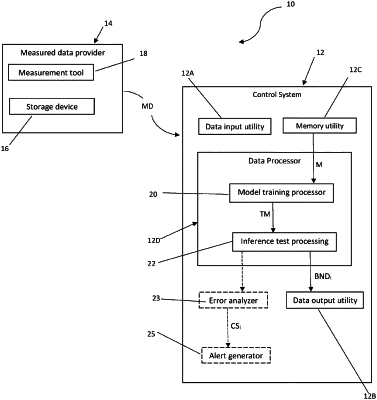| CPC G03F 7/70508 (2013.01) [G03F 7/70625 (2013.01)] | 26 Claims |

|
1. A system for controlling measurements of various sample's parameters, the system comprising:
a control unit configured as a computer device comprising data input and output utilities, memory, and
a data processor, and being configured to communicate with a measured data provider to receive measured data indicative of measurements on the sample, wherein the data processor is configured to perform model-based processing of the measured data utilizing at least one predetermined model, and determine, for each of one or more measurements of one or more parameters of interest of the sample, an estimated upper bound on an error value for the measurement individually, and generate output data indicative thereof;
wherein said data processor is configured to perform said model-based processing comprising:
applying a training stage to at least one predetermined model to obtain a corresponding at least one trained model and using said trained model to determine a functional relation between the measured data and upper bounds on errors for each measurement individually of each respective sample's parameter affecting the measured data; and
performing an inference test stage by applying said functional relation to the measured data, to associate the individually estimated upper bound of the error value individually with each of said one or more parameters of a sample being measured;
wherein said training stage of the model-based processing comprises:
while training said at least one predetermined model using the measured data and trainset, determining a distance metric, DF, in a signal parametric space, and obtaining a trained model;
utilizing predicted model parameters of the trained model to determine a distance metric, DE, in an error parametric space, for predicted measurement errors with respect to the model trainset; and
determining a relation between the upper bounds of errors for the sample's parameters and said distance metric DE, thereby defining said functional relation between the measured signals and the upper bounds of the errors.
|